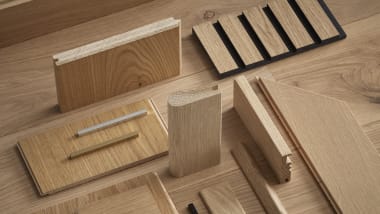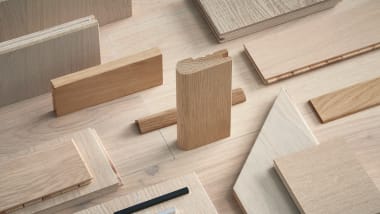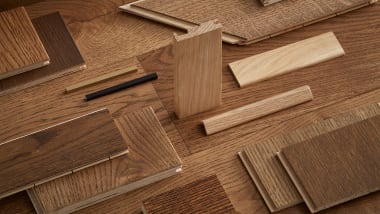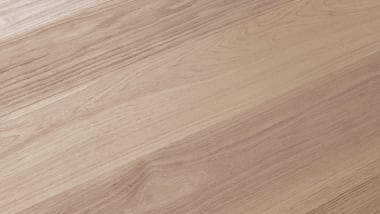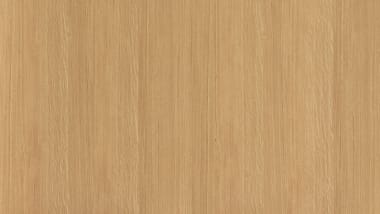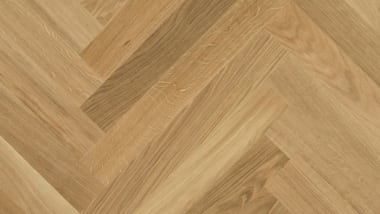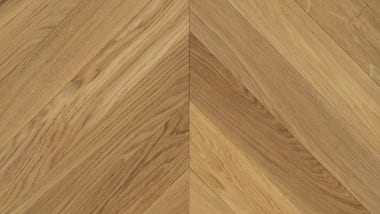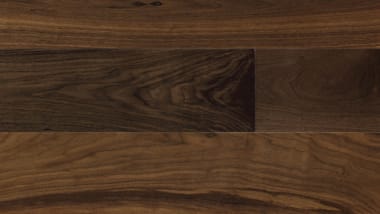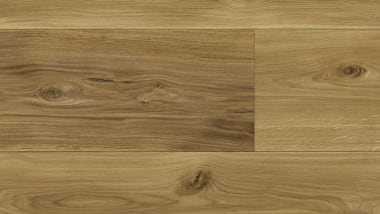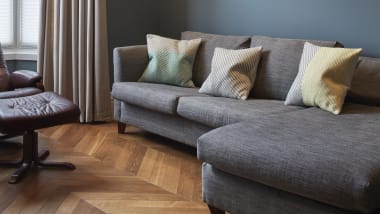Parquet Flooring: Everything You Need to Know
6 Dec 2022
Parquet flooring is the mosaic of the wooden flooring world. Stylish, durable, and sustainable—a parquet floor is a statement in any home or modern apartment.
Beautifully intricate and elegant, parquet flooring is the term used to describe the geometric patterns made from multiple wooden panels. The word “parquet” is French for “a small compartment” and explains the use of decoratively laying wooden pieces in an intricate pattern.
If you’re reading this, it means you’re curious about the history, origin, style and longevity of parquet floors. Read on to discover everything you need to know about wood parquet, and whether it could be suitable for your next project.
Where does parquet flooring come from?
Parquet flooring has a rich and royal history, starting in 16th century France. Skilled artisans would lay interlocking wooden panels into geometric shapes to replace troublesome stone or marble flooring.
Weighing a lot less than stone or marble, the new parquet floors put less strain on the timber framework and would be easier to maintain.
King Louis XIV replaced the marble floors in the rooms of the Palace of Versailles with what is now known as the design “Parquet de Versailles”. Ever since, parquet flooring has been synonymous with elegance, prestige, and luxury.
What are the different styles of parquet flooring?
When it comes to parquet flooring, the style and durability of a wooden floor cannot be overstated. The geometric designs of a parquet floor are stylish, timeless, and exude an effortless elegance that can transform your space.
As parquet flooring refers to a geometric pattern of inlaid panels of wood, there can be an almost infinite number of parquet designs. However, the four most popular parquet flooring designs are:
1. Herringbone parquetry
The Herringbone design is made up of panels of wood of equal length, cut into rectangles with flat 90° angles. The end of each plank is placed to touch the side of another panel, forming a beautiful and stable design that limits movement as the planks are tightly packed together.
2. Chevron parquetry
Similar to the herringbone design, the length of the planks of wood in Chevron parquetry are made equal. However the ends are cut at an angle so when the top end of a plank is placed against another, it makes a “V” shaped pattern also known as a chevron.
3. Versailles parquetry
As we have touched on earlier, this pattern is made famous for its use in the grand Palace of Versailles. This design is beautifully intricate, with interlacing diagonals. Versailles is a truly elegant statement piece.
4. Mosaic (or “Brick”) parquetry
The mosaic or “brick” pattern is a simple, yet effective design, made up of small rows of wooden panels (usually in rows of two or four) that form square tiles. The mosaic pattern is achieved by placing each tile perpendicular to the tile that is next to it to form a simple by pleasing effect on the eye.
Are parquet floors real wood?
In short, yes! Though options on the market cover everything from laminate to wood, our range of parquet flooring options at Havwoods are predominantly made from engineered wood.
Our engineered hardwood flooring has advantages over traditional solid hardwood flooring. It’s more stable and gives you greater installation options. That means they retain the durable characteristics of a traditional wooden floor — all without compromising on the variety of finishes, textures, and patterns with which parquet has become synonymous.
Examples of vinyl flooring and other materials that try to achieve the look of wood are also available in the market.
What are the pros and cons of parquet flooring?
Here are 5 pros and cons to consider when choosing a parquet floor if you’re renovating your home or apartment.
Pros of a parquet floor:
1. Durable
Parquet flooring was originally used to replace marble and stone floors, which means it’s very durable and, as it’s made of hardwood, will show very little signs of normal wear and tear over the years. Your parquet floors can last for many, many decades!
2. Allergy-friendly
Parquet flooring is a great option for those with allergies—especially those with asthma or carpet allergies. As parquet flooring is easy to clean, keeping your floors free from dust and other causes of allergic reactions is easy to do. There are no long fibers, such as those stuck in carpets, to trap irritants such as pet hair, pet dander, and dust mites to get caught up in.
All you need to do is a quick mop every couple of weeks, and a vacuum every few days, to keep your floors looking tidy.
3. Stylish
A wooden parquet floor makes a beautiful and stylish statement for any home or modern apartment. Parquet is a symbol of fine craftsmanship and built to last. There is such a wide range of designs, colors, and grains of wood to choose from with a parquet floor, which means you can select something as unique as the space it covers.
4. Stable
Because parquet flooring is made from interlocking hardwood planks, there is naturally less movement than what may occur in other wood floors.
There are often multiple layers to a parquet floor, with the layers beneath the hardy ‘wear’ layer (the layer that is exposed) absorbing the impact and ensuring a firm and stable result.
5. Sustainable
Wooden parquet flooring is some of the most sustainable and environmentally friendly flooring around. Wood is a renewable resource, so as long as we keep on planting the hardwood species that work best for parquetry, we won’t run out!
Parquet flooring without a tongue and groove can also be restored time and time again, meaning the same flooring can be in place for hundreds of years if maintained appropriately.
There’s also the option to opt for reclaimed wood, which is a unique way to give a new lease of life to the material. At Havwoods, our reclaimed wood tells a story. Many of our reclaimed wood flooring planks date back to over 300 years ago, and come from the times of the early settlers who would fell trees in the winter and transport the logs downstream to make buildings such as houses, barns, farms and stores.
We also have a beautiful range of reclaimed wood called the Venetian Lagoon Herringbone which, as the name suggests, has spent many decades under the waters of Venice as mooring posts and navigational markers in the iconic Italian city.
Cons of a parquet floor
1. Scratches on wood
As with all wooden floors, a wooden parquet floor can be marked or dented by dropping sharp objects onto the floor, or scratched by dragging heavy furniture across it.
Deep scratches and gouges can be hard to fix, but they can be fixed by a professional. Small scratches may be unavoidable, but those with pets (such as dogs) may find certain parquet flooring with darker tones show scratches easier than others. It’s a good idea to use doormats for the home’s entrances to avoid marks from shoes (such as high heels), and carpet runners or rugs in high-traffic areas of your home.
In many cases, light scratches and marks add character to the flooring and are signs of a well-lived and loved home.
2. Damaged by moisture
Due to being made of wood, moisture and humidity are the natural enemy of parquet. Parquet flooring may not be a good idea for bathrooms, or anywhere where water may sit and pool on the flooring for a period of time.
It’s important to keep a wooden parquet floor nice and dry to avoid warping or expanding over time.
3. Requires maintenance
Parquet flooring will require maintenance as time goes on. It’s important to reseal your floors when needed, or simply make the choice to sand and polish the floor to ensure your wooden panels stay looking their best for many more years to come. You should only need to do this every 20 or 30 years.
4. Color can fade
If your flooring is exposed to intense and direct sunlight, this can fade and ‘wash out’ the color of your parquet flooring. If your flooring will be exposed to direct sunlight, it might be worth thinking about using curtains or blinds that block the light during the brightest and UV-intense times of the day.
5. Flooring can be noisy
As with all solid floors, there is the potential for a parquet wooden floor to be noisy underfoot, especially if you wear shoes in the house. Expert installation with adequate insulation under the wooden planks can, however, reduce the noise.
It is also a good idea to swap the shoes you wear on the streets with a pair of slippers or other indoor friendly alternatives. This’ll also eliminate the potential for scuffing the wood flooring with the dark rubber on your shoes.
In reality, the pros of parquet flooring heavily outweigh the cons of a Havwoods parquet floor. The craftsmanship of the parquet designs is not only sustainable and environmentally friendly, it also adds value to your property by adding a bold and beautiful accent to any room.
Why choose Havwoods parquet wood flooring?
Parquet flooring is a byword for luxurious living and stylish interior design. First used to replace heavy marble and stone floors in 16th century France, culminating in being the floor design of choice at the Palace of Versailles—parquetry is an incredibly beautiful way to make your floors a centerpiece of your home or apartment.
When cared for correctly, a hardwood parquet floor can last for generations, providing sustainable, comfortable and stable flooring for years to come.
If you have any questions about the Havwoods range, or you’re trying to decide whether parquet flooring is the right choice for your home, then contact us for a free consultation, or visit a Havwoods showroom and pick up a sample today.
